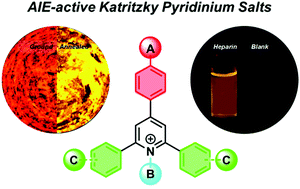From simple Katritzky salts to AIEgens: mechanochromic luminescence and heparin detection†
Abstract
Developing and exploring efficient fluorophores are of fundamental significance for sensing and tracking chemical or biological species and processes. Herein, a series of novel AIEgens derived from Katritzky pyridinium salts have been readily synthesized via a condensation reaction between their corresponding pyrylium precursors and versatile primary amines such as alkylamine and amino acid derivatives. The model compound TPP1 with a 2,4,6-triphenylpyridinium skeleton showed a smooth AIE curve without an inflection point, and the emission enhancement was attributed to the formation of water clusters around the pyridinium ring and the subsequent nano-aggregate formation, which hindered their intramolecular motions. Moreover, tetraphenylethene moiety-conjugated Katritzky salts retained classical AIE properties and were endowed with larger Stokes shifts and red-shifted emissions. Moreover, all these cationic AIE-active chromophores exhibited obvious mechanofluorochromism behaviors with red-shifted luminescence upon grinding and blue-shifted emission after solvent annealing. The existence of the positively charged pyridinium ring endowed these luminogens with the capability to selectively detect Heparin in aqueous media from other ionic biopolymers.

- This article is part of the themed collection: Recent Progress on Aggregation-Induced Emission


 Please wait while we load your content...
Please wait while we load your content...